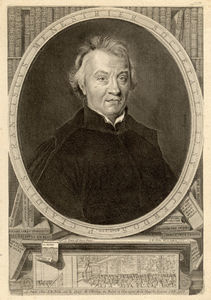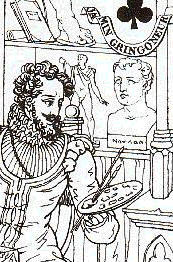|
Tarot History Search started September 2004 |
Claude-Francois Pere Menestrier (1631 - 1705) | ||
|
The "Father" of Playing Card research, Claude François Menestrier, also "Pére Menestrier", started these activities short before the end of his life with a rather short article, given as a part of his Bibliotheque curieuse et instructive De divers Ouvrages Anciens & Modernes de Litterature & des Arts (Ouverte pour les Personnes qui aiment les Lettres in 1704, in vol. 2, p. 168 with the subtitle Des Principes des Sciences & des Arts
disposez en forme de jeux. I don't know it for sure, but it might have been the last of his creative output, which found to publication after a long life filled with writing. New Advent, 1914 offers this information: "Antiquarian, b. at Lyons, 9 March, 1631; d. at Paris, 21 Jan., 1705. He inherited a taste for antiquities, his great-uncle Claude Menestrier having been employed by Cardinal Barberini (Urban VIII) as librarian to collect art objects and medals. A pupil of the College of the Trinity, Lyons, which was in charge of the Jesuits, he entered the Society there, and at the age of fifteen was professor of rhetoric; in this capacity he composed the ballets "Destinées de Lyon" and "L'autel de Lyon" and arranged the plays which were performed before Louis XIV when he visited Lyons in 1658. He also directed the festivities which took place at the time of the marriage of Françoise d'Orléans and Charles Emmanuel, Duke of Savoy, as also of the solemnities wherewith the Visitandines of Chambéry celebrated the canonization of St. Francis de Sales. But he was more than an organizer of spectacles; he issued important publications on heraldry which led him into violent disputes with Claude le Laboureur, provost of L'ile Barbe; he also made a study of emblems and mottoes. Stationed at Paris from 1670, he preached successfully for twenty-five years in the principal towns, during which time he also composed Latin inscriptions for LeBrun's prints, for the battle pictures of Van der Meulen, as well as supervising the decorations for Turenne's obsequies and writing, among other important books, "Histoire de Louis le Grand par les medailles, devises, inscriptions et armoiries" (1689) and "Histoire civile ou consulaire de la ville de Lyon" (1696). He had planned a vast synthesis of knowledge, the "Philosophie des images", in which were to be included his numerous and strangely varied volumes. In 1682 he had discovered in the Cistercian abbey at Villiers the tomb of Queen Anne or Agnes of Russia, second wife of Henry I. In 1770, in the second edition of the "Gallia christiana", he was accused of falsehood in this connection, but the discovery by Prince Labanoff in 1825 of a diploma bearing the seal of this queen vindicated Menestrier's memory. The bibliography of Menestrier's works is so considerable that it disconcerts bibliophiles." The deciding turning point in Menestriers' life seems to have been his chance to arrange the festivities for Louis XIV. in 1658, when the young king visited Lyon. A moment of triumph, as we at trionfi.com know it from other opportunities and with some logic Menestrier ended finally after a long interesting and very active life at the object of the Trionfi cards, which he declared to be the work of Gringonneur in 1392. As he himself had close relationships to the city of Lyon and Lyon was really ca. 1490 - 1510 the center of European playing card production he also found, that playing cards generally originated in France, a statement, which reigned public opinion till 1780 by the work of Abbé Rive (declared, that cards are from Spain), in short time (1781) followed by Court de Gebelin (Tarot is from Egyptia) and by Breithaupt (1784), who explained his work modestly as a "Versuch" to explain something. His topics varied (83 publications totally) and his note to playing cards is in relation to his complete work only of minor importance. For instance he's called the most influential heraldic writer in the 17th century. In a dispute about the Prophecies of Malachy Menestrier took a strong position: "In the seventeenth century Father Menestrier, a famous Jesuit, put forward his hypothesis that these prophecies had originated in 1590 during the conclave which resulted in Gregory XIV becoming the elected pontiff. Fr. Menestrier goes as far as naming the forger; a member of Cardinal Simoncelli's party is supposed to have forged these prophecies in order to influence the electors in favour of his Cardinal who was the doyen of the Sacred College and, by virtue of his office and other qualities, surely a favourite for the pontificate. Cardinal Simoncelli was Bishop of Orvieto, his birthplace, and the motto given to him in the prophecies, Ex
The text is complete in the web, (click below) - as it contains 2 volumes and each starts with its own numbering it has 2 pages "168": Bibliotheque curieuse et instructive de divers ouvrages anciens & modernes ... By Claude-François Menestrier Own Links Foreign Links Other Publications
|
 Père Menestrier  Jaquemine Gringonneur on a playing card (1815) | |
| © copyright:
autorbis.net. Links at the site might lead to foreign
sources. We're not responsible for the contents of
these sites.
If you're interested to communicate or to add
informations to some of our articles or to publish articles to the theme of Tarot in 15th century, please send your mail to the webmaster |